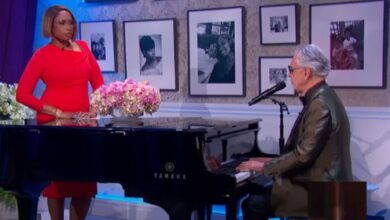Roy Orbison’s ‘Crying’ – A Haunting Ballad That Redefined Emotion in Music
When Crying was released in 1961, Roy Orbison had already established himself as a unique voice in rock and roll, but this song elevated him to another level entirely. With its soaring orchestration, deeply personal lyrics, and an unmatched vocal performance, Crying became a defining moment in Orbison’s career. It reached No. 2 on the Billboard Hot 100, topped the charts in Canada, and cemented Orbison’s place as one of the most emotive and powerful singers of his generation. Over the years, it has been recognized as one of the greatest songs ever recorded, with Rolling Stone ranking it among the “500 Greatest Songs of All Time.”
Orbison’s path to stardom had been anything but typical. Born in Texas in 1936, he initially pursued country music before finding his place in the emerging rock and roll scene of the late 1950s. Unlike the hip-shaking energy of Elvis Presley or the rebellious edge of Chuck Berry, Orbison’s approach was built on raw emotion and dramatic storytelling. His operatic voice and melancholic delivery set him apart from his contemporaries, making him a unique force in music.
The inspiration for Crying came from a personal experience of unrequited love. Orbison once recounted how a chance encounter with an old flame left him devastated, realizing he had been suppressing his emotions until they surfaced in the form of tears. Alongside songwriter Joe Melson, he crafted a ballad that encapsulated the feeling of heartbreak in its most profound form. Rather than a simple love song, Crying was an admission of vulnerability, something that few male artists in the early ‘60s dared to explore.
Recording Crying was a meticulous process. Produced by Fred Foster, the track featured lush orchestration with swelling strings and a gentle yet dramatic build-up. Orbison’s signature vibrato and wide vocal range were on full display, reaching a climactic high note that left listeners breathless. Unlike most rock and roll tracks of the time, which relied on rhythmic drive and youthful energy, Crying was almost cinematic, unfolding like a three-act drama. The orchestral arrangement complemented Orbison’s delivery, making the song feel grand yet intensely personal.
Upon its release, Crying was met with overwhelming praise. It became one of Orbison’s biggest hits, staying on the charts for months and helping solidify his status as a leading artist of the era. The song’s blend of operatic grandeur and heart-wrenching storytelling was groundbreaking, bridging the gap between rock, pop, and orchestral balladry. It also won Orbison a Grammy years later when he re-recorded it as a duet with k.d. lang in 1987, proving its enduring appeal.
Beyond the charts, Crying had a significant cultural impact. It reshaped the way male vulnerability was presented in popular music. At a time when many songs depicted love in a simplistic or upbeat manner, Orbison dared to express heartbreak in its rawest form. This emotional depth resonated with listeners, making the song a staple on radio stations and jukeboxes for years to come.
For Orbison, Crying was a turning point. It expanded his international reach and reinforced his ability to craft timeless ballads. He went on to record more orchestral-driven hits like In Dreams and It’s Over, further developing his distinctive style. The success of Crying also allowed him to tour extensively, gaining a dedicated following in Europe, particularly in the UK, where he would later influence artists like The Beatles and The Rolling Stones.
The song’s influence extended beyond Orbison’s career. It paved the way for future rock ballads that embraced grandiose arrangements and deep emotional storytelling. Artists such as Elvis Presley, Chris Isaak, and even modern crooners like Lana Del Rey have cited Orbison’s style as an inspiration. The song was also covered by numerous artists, most notably Don McLean, whose 1980 rendition brought Crying back into the spotlight and introduced it to a new generation of listeners.
Several legendary musicians have paid tribute to Crying over the years. k.d. lang’s 1987 duet with Orbison remains one of the most poignant reimaginings, earning them a Grammy Award and exposing the song to younger audiences. Don McLean’s version topped the UK charts, proving that the song’s message was universal and timeless. Each cover brought a new interpretation, but none could match the original’s raw intensity.
At the time of its release, Orbison was at a personal and professional high, but his life was marked by both triumph and tragedy. Just a few years later, he faced immense personal loss, including the deaths of his wife and two sons in separate incidents. Despite these hardships, he continued making music, and his legacy only grew stronger.
Decades after its debut, Crying remains a defining piece of Orbison’s legacy. It has been featured in films, television shows, and countless retrospectives on the evolution of rock and pop music. The song’s emotional resonance ensures that it still captivates listeners, whether they’re experiencing heartbreak for the first time or revisiting a familiar ache from the past.
In many ways, Crying changed how ballads were perceived in popular music. It proved that songs of sorrow could be just as powerful as songs of joy, and it challenged the notion that rock and roll was solely about energy and rebellion. Instead, it introduced a new kind of power—one rooted in deep, unfiltered emotion.
Roy Orbison’s career spanned decades, and his influence on music remains immeasurable. Yet, among all his remarkable songs, Crying stands as a testament to his unparalleled ability to convey human emotion through song. It wasn’t just a hit; it was an experience—one that continues to move listeners, generation after generation.


